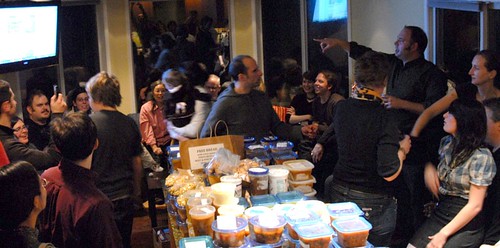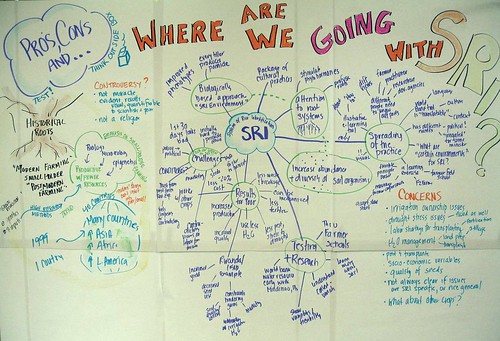Thanks to Gauri, a fun tool to visualize your Twitter friends and followers. I like how all of you look together! Very cool!
How are we building our “community soil?
Via Hyperlocavore, I watched this video on preparing an urban, raised-bed garden. It focuses on the building of raised beds, using rotating small animal waste, and hoop houses to get an early start on the gardening season. If you are interested in gardening, take a look at the video. If not, skip the video and hop below for the online community connection.
Last week, I pondered the agricultural metaphor for knowledge sharing. The idea of “gardener” as a community role is not new, nor is the ecosystem metaphor.
So what are the practices for communities that are akin to the late winter preparation for Spring gardening?
In the video, Gardening Girl talks about:
- start with clean, well drained soil
- use a modular design so you can easily take care of your garden
- use all the creatures available – chickens and rabbit hutches rotated over dormant beds to do off season soil building (in other words, good s$%#)
- take advantage of free stuff to build soil – leaves and grass clippings
- cover unused beds
- build simple hoop houses to get an early start on the season (she even shows us how – it’s easy!)
- raised beds take the back breaking work out of gardening, bringing the garden to you
- intensive gardening saves water and increases yield
From an online community building perspective, this might translate to:
- Clean soil – simple environment. Make sure the technology you use is aligned to the core needs of the community – what tasks do they need to do together. Other stuff can be added later, but if you start with a mess, you’ll end with a mess.
- Modular – can tools, processes and content for or developed by the community be used easily in different ways? Can you repurpose something for another use if needs change or you need to expand or contract? Can you easily add and subtract activities and tools?
- All the Creatures – who is already doing something similar? Are there early joiners who have something to add to the initial start up building and process? Use what is available! Be creative. Don’t let things go to waste!
- Use the Free Stuff – Look around and see what free things can support (build the soil) your community. Can you put up with some ads and use a free tool? Can you recycle existing resources (and save the earth a bit along the way). If you have a budget, where is it best spent? On tools, or the rare chance for a face to face? On technology, or chocolate? (well, I may be getting carried away.) Make recycled chic and focus your resources where they count – on people.
- Cover Unused Beds – empty spaces create empty feelings. Is some part of the community technology configuration unused? Are there dead forums? Pull out the good content and recycle it elsewhere, and either archive of button up the empty spaces. But be careful about what you delete. See these threads on the ComPrac list about the dangers of assumptions about archives.
- Hoop Houses for Early Starts – sometimes online communities need a smaller, protected space to germinate, build trust and get strong to withstand some of the buffets of the open world. This may mean finding an existing set of core members and gradually growing, or creating a little hot house to get things going.
- Raise the Beds – like higher planting boxes that reduce stooping, bringing community as close to where people are now rather than making them go further out of their way to participate. Can you piggy back on their community rather than starting a new one? Are there some simple overlaps or complementarities that suggest some sort of cross community collaboration?
- Intensive Gardening – good soil retains water and has greater yields. Good nurturing, leadership, stewardship and followership makes it easier for communities to focus on why they came together in the first place. This is not about control, but creating space and conditions for success. So a little extra work up front can go a long way. But like anything, don’t get carried away. Like a garden, a community has its seasons and it changes over time. Be as intensive as is right for the moment!
So is Spring approaching in your community? What are you doing to prepare?
How Could I have missed the annual Soup Swap?
 I live in a place that is cold, dark and wet in the winter, something that can only be assuaged by good friends, more chocolate and soup. I am thinking about making split pea soup this very minute but instead, I was doing some blog reading catch up on Nerd’s Eye View – a Seattle blogger – and saw her post on a Seattle Soup Swap.
I live in a place that is cold, dark and wet in the winter, something that can only be assuaged by good friends, more chocolate and soup. I am thinking about making split pea soup this very minute but instead, I was doing some blog reading catch up on Nerd’s Eye View – a Seattle blogger – and saw her post on a Seattle Soup Swap.
Waaah. I missed it. No matter that day I had just returned from 20 hours of international travel and was asleep by the time they started, but just the idea is delicious. It is such a community indicator. When people ask about the most important part of facilitating a F2F event, i say “the communal meals.” Even better if they are home made, pot luck, or if in a restaurant, family style. Where the sound level is quiet enough to hear each other converse, but not so quite you feel embarassed to guffaw out loud. Or worse, laugh with your mouth full of food.
While there is SO much we can do together online, I have yet to find the thing that creates the experience of a shared meal. I have been in online chats where each of us, at our distributed location, eats and writes about what we are eating. But it is a different experience. The hosting act of providing a tenderly cooked meal, or even sharing your store bought cookie, is a uniquely human, embodied experience. It ain’t the same online.
There is one ritual of the soup swaps that I find entrancing. Knox Gardner writes about it from the recent Seattle Swap:
It takes quite a while for the “Telling of the Soup” to get around the room when there are twenty-two soups, but it’s worth it. Without the Telling, it’s an empty power grab. With the telling, the humaneness of sharing food together shines right through. It’s essential.
Here is another soup swap post worth reading.
Want to set up your own Soup Swap? You can find all the how-to’s at Soup Swap
Photo from Nerds Eye View on Flickr
Brandy Agerbeck’s Obama Speach Visual Capture
For those of you interested in visual thinking and graphic recording, take a look at this! Brandy was inspired to do a visual capture of Obama’s inaguration speech – something quite different than she normally does.
Brandy Agerbecks Graphic Facilitation Work
I was really interested to read about her process…
… I ended up scribbling down the main points I heard in pencil on a notebook. Not a real-time drawing. And as I scribbled notes, I realized that it was critical to quote Obamas words. One of my skills is to distill points into shorter, clearer phrases. Because this content was recorded and would be quoted, it was good to keep it in Obamas voice, even if it took my shape, my synthesis.
After I scribbled the notes, I downloaded a transcript. I highlighted the phrases that resonated with me when I listened live. Next, I needed to figure out how to wrap these points around the Obama banner I had drawn as a centerpiece. I started knowing that the O would be a face saying a major point. I chose to make that “Greatness is never a given. It is earned.” I built the main point around the banner, though not strictly in linear order.
I was very curious what pieces of the speech would be made into soundbites. As I prepped this image, I listened to NPR and I was glad to hear a lot of the pieces of the drawing being repeating on air.
Her reflection about capturing Obama’s exact words brought to mind one of the challenges/questions I face when doing either text or visual summaries of group conversations. How important is individual recognition and ownership of the words? When are quotes essential and when does distillation add more. Clearly in this case there was a sole focus on Obama. But Brandy’s articulation of the point gave me food for thought.
What do you do when you summarize online or F2F group interactions? What is your harvesting practice?
SRI and Knowledge Sharing

First, the scholars working on SRI were insistent it was not a proscribed method of growing rice that is useful to poor, small holder farmers, but that it was a set of principles for growing rice and other crops.
A set of principles.
Can we view knowledge sharing not as a proscribed set of practices, but instead a set of principles?
While there are a range of tools and methods that we call “knowledge sharing,” they are just tools. And if we overly focus on them, we miss the point that knowledge sharing is embedded in everything we do. Therefore, to make sure we have time for KS and that we do it well and strategically, we might instead focus on the princples that support KS.

So what might those principles be?
Saturday morning, on my way home from Rome at the unnatural hour of 5:15 am, I was surprised to look up in the airport to see a colleague who was at the joint Share Fair in Rome and a past participant of the online KS workshop I have facilitated for FAO and CGIAR. Justin Chisenga of FAO shared the challenges of KS in agriculture in Ghana. He said there were no precedents for sharing agricultural research, but instead a culture of individual ownership, and thus very often loss, of agricultural research knowledge. Locked up in files or personal computers, and unknowingly discarded upon retirement or death, years of knowledge had leaked away. Ownership, not public good.
- What principles could change from lock down to flow in Ghana?
- What principles could encourage funders to reframe their support towards openness and learning?
- What principles could reframe organizational and national policies to support and reward building public instead of private good in fields that ostensibly are dedicated to things like feeding one’s country, region or world?
- What principles could allow people to share knowledge even in large, complex and necessarily political organizations?
My mind returned to what I learned about SRI. SRI focuses attention on the quality of seed, the timing and method of rice seedling transplantation, and THE HEALTH OF THE SOIL and the microorganisms that live there.
What is the soil for knowledge sharing? How do we know it is healthy? What “transplantation” practices allow us to move fragile new knowledge from one place and allow it to thrive in another, without too much loss, or too much investment in water and fertilizer? How should we “weed” to keep information overload from overwhelming us?
The analogy is intriguing me.
Rice tending image from Wikipedia
